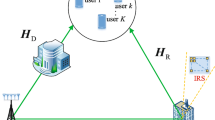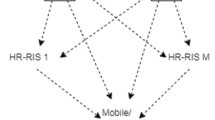Abstract
The number of bits required in phase shifters (PS) in hybrid precoding (HP) has a significant impact on sum-rate, spectral efficiency (SE), and energy efficiency (EE). The space and cost constraints of a realistic massive multiple-input multiple-output (MIMO) system limit the number of antennas at the base station (BS), limiting the throughput gain promised by theoretical analysis. This paper demonstrates the effectiveness of employing an intelligent reflecting surface (IRS) to enhance efficiency, reduce costs, and conserve energy. Particularly, an IRS consists of an extensive number of reflecting elements, wherein every individual element has a distinct phase shift. Adjusting each phase shift and then jointly optimizing the source precoder at BS and selecting the optimal phase-shift values at IRS will allow us to modify the direction of signal propagation. Additionally, we can improve sum-rate, EE, and SE performance. Furthermore, we proposed an energy-efficient HP at BS in which the analog component is implemented using a low-resolution PS rather than a high-resolution PS. Our analysis reveals that the performance gets better as the number of bits increases. We formulate the problem of jointly optimizing the source precoder at BS and the reflection coefficient at IRS to improve the system performance. However, because of the non-convexity and high complexity of the formulated problem. Inspired by the cross-entropy (CE) optimization technique used in machine learning, we proposed an adaptive cross-entropy (ACE) 1-3-bit PS-based optimization HP approach for this new architecture. Moreover, our analysis of energy consumption revealed that increasing the low-resolution bits can significantly reduce power consumption while also improving performance parameters such as SE, EE, and sum-rate. The simulation results are presented to validate the proposed algorithm, which highlights the IRS efficiency gains to boost sum-rate, SE, and EE compared to previously reported methods.







Similar content being viewed by others
Data availability
When required, data will be made accessible.
Code availability
Simulation codes will be given after paper acceptance at the following link https://github.com/Hassanbangash12.
References
Ahmed, I., Khammari, H., Shahid, A., et al. (2018). A survey on hybrid beamforming techniques in 5g: Architecture and system model perspectives. IEEE Communications Surveys & Tutorials, 20(4), 3060–3097.
Alwazani, H., Kammoun, A., Chaaban, A., et al. (2020). Intelligent reflecting surface-assisted multi-user miso communication: Channel estimation and beamforming design. IEEE Open Journal of the Communications Society, 1, 661–680.
Baranidharan, V., Moulieshwaran, B., Karthick, V., et al. (2022). Survey on channel estimation schemes for mmwave massive mimo systems–future directions and challenges. In Expert Clouds and Applications: Proceedings of ICOECA 2022. Springer, p.p 505–515.
Björnson, E., Larsson, E. G., & Marzetta, T. L. (2016). Massive mimo: Ten myths and one critical question. IEEE Communications Magazine, 54(2), 114–123.
Chen, W., Ma, X., Li, Z. et al. (2019). Sum-rate maximization for intelligent reflecting surface based terahertz communication systems. In 2019 IEEE/CIC International Conference on Communications Workshops in China (ICCC Workshops), IEEE, pp. 153–157.
Cheng, X., Gao, S., Yang, L., (2022). Millimeter-wave massive mimo vehicular channel modeling. In mmWave Massive MIMO Vehicular Communications. Springer, pp. 7–38.
Das, S. K., Benkhelifa, F., Sun, Y., et al. (2023). Comprehensive review on ml-based ris-enhanced iot systems: Basics, research progress and future challenges. Computer Networks, pp. 109581.
Dong, R., He, H., Shu, F., et al. (2023). Joint beamforming and phase shift design for hybrid-irs-aided directional modulation network. arXiv preprint arXiv:2301.02831
Du, W., Chu, Z., Chen, G., et al. (2022). Weighted sum-rate and energy efficiency maximization for joint its and irs assisted multiuser mimo networks. IEEE Transactions on Communications, 70(11), 7351–7364.
Gao, X., Dai, L., Sun, Y., et al. (2017). Machine learning inspired energy-efficient hybrid precoding for mmwave massive mimo systems. In 2017 IEEE International Conference on Communications (ICC), IEEE, pp. 1–6.
Guo, H., Liang, Y. C., Chen, J., et al. (2020). Weighted sum-rate maximization for reconfigurable intelligent surface aided wireless networks. IEEE Transactions on Wireless Communications, 19(5), 3064–3076.
Guo, M., Gursoy, M. C. (2023). Joint activity detection and channel estimation for intelligent reflecting surface assisted wireless iot networks. IEEE Internet of Things Journal.
Huang, C., Alexandropoulos, G. C., Zappone, A., et al. (2018). Energy efficient multi-user miso communication using low resolution large intelligent surfaces. In 2018 IEEE Globecom Workshops (GC Wkshps), IEEE, pp. 1–6.
Huang, C., Zappone, A., Alexandropoulos, G. C., et al. (2019). Reconfigurable intelligent surfaces for energy efficiency in wireless communication. IEEE Transactions on Wireless Communications, 18(8), 4157–4170.
Li, G. H., Yue, D. W., & Qi, F. (2022). Joint beamforming and power allocation for intelligent reflecting surface-aided millimeter wave mimo systems. Wireless Networks, 28(5), 1935–1947.
Li, S., Yan, S., Bariah, L., et al. (2023). Irs-assisted full duplex systems over rician and nakagami fading channels. IEEE Open Journal of Vehicular Technology.
Ma, X., Chen, Z., Chen, W., et al. (2020). Intelligent reflecting surface enhanced indoor terahertz communication systems. Nano Communication Networks, 24, 100284.
Méndez-Rial, R., Rusu, C., González-Prelcic, N., et al. (2016). Hybrid mimo architectures for millimeter wave communications: Phase shifters or switches? IEEE Access, 4, 247–267.
Mumtaz, S., Rodriguez, J., & Dai, L. (2016). MmWave massive MIMO: a paradigm for 5G. Academic Press.
Rubinstein, R. Y., & Kroese, D. P. (2013). The cross-entropy method: a unified approach to combinatorial optimization. Monte-Carlo simulation and machine learning: Springer Science & Business Media.
Salahdine, F., Han, T., Zhang, N. (2023). 5g, 6g, and beyond: Recent advances and future challenges. Annals of Telecommunications, pp. 1–25.
Tan, F., Xu, X., Chen, H., et al. (2023). Energy-efficient beamforming optimization for miso communication based on reconfigurable intelligent surface. Physical Communication, pp. 101996.
Wu, Q., & Zhang, R. (2019). Towards smart and reconfigurable environment: Intelligent reflecting surface aided wireless network. IEEE Communications Magazine, 58(1), 106–112.
Wu, Q., Zhang, S., Zheng, B., et al. (2021). Intelligent reflecting surface aided wireless communications: A tutorial. IEEE Transactions on Communications.
Xiu, Y., Zhao, J., Sun, W., et al. (2021). Reconfigurable intelligent surfaces aided mmwave noma: Joint power allocation, phase shifts, and hybrid beamforming optimization. IEEE Transactions on Wireless Communications, 20(12), 8393–8409.
Xu, S., Du, Y., Liu, J., et al. (2022). Weighted sum rate maximization in irs-backcom enabled downlink multi-cell miso network. IEEE Communications Letters, 26(3), 642–646.
Zhang, J., Björnson, E., Matthaiou, M., et al. (2020). Prospective multiple antenna technologies for beyond 5g. IEEE Journal on Selected Areas in Communications, 38(8), 1637–1660.
Zhang, Y., Zhong, C., Zhang, Z., et al. (2020). Sum rate optimization for two way communications with intelligent reflecting surface. IEEE Communications Letters, 24(5), 1090–1094.
Zhou, G., Pan, C., Ren, H., et al. (2020). Intelligent reflecting surface aided multigroup multicast miso communication systems. IEEE Transactions on Signal Processing, 68, 3236–3251.
Zuo, J., Liu, Y., Basar, E., et al. (2020). Intelligent reflecting surface enhanced millimeter-wave noma systems. IEEE Communications Letters, 24(11), 2632–2636.
Acknowledgements
The work was supported by the National Natural Science Foundation of China under Projects 62071206
Author information
Authors and Affiliations
Contributions
SuH: preparation, data collection, analysis, drafting of the paper and study conception; ZY: Design, conception, critical review of intellectual content, and supervision; TM: collection, evaluation, and proofreading of data; and UM supervision and critical revision.
Corresponding author
Ethics declarations
Conflict of interest
The work described in this paper does not appear to have been influenced by any known competing financial interests or personal relationships, according to the authors.
Rights and permissions
Springer Nature or its licensor (e.g. a society or other partner) holds exclusive rights to this article under a publishing agreement with the author(s) or other rightsholder(s); author self-archiving of the accepted manuscript version of this article is solely governed by the terms of such publishing agreement and applicable law.
About this article
Cite this article
Hassan, S.u., Ye, Z., Mir, T. et al. Machine learning-inspired hybrid precoding with low-resolution phase shifters for intelligent reflecting surface (IRS) massive MIMO systems with limited RF chains. Wireless Netw (2024). https://doi.org/10.1007/s11276-024-03748-8
Accepted:
Published:
DOI: https://doi.org/10.1007/s11276-024-03748-8




